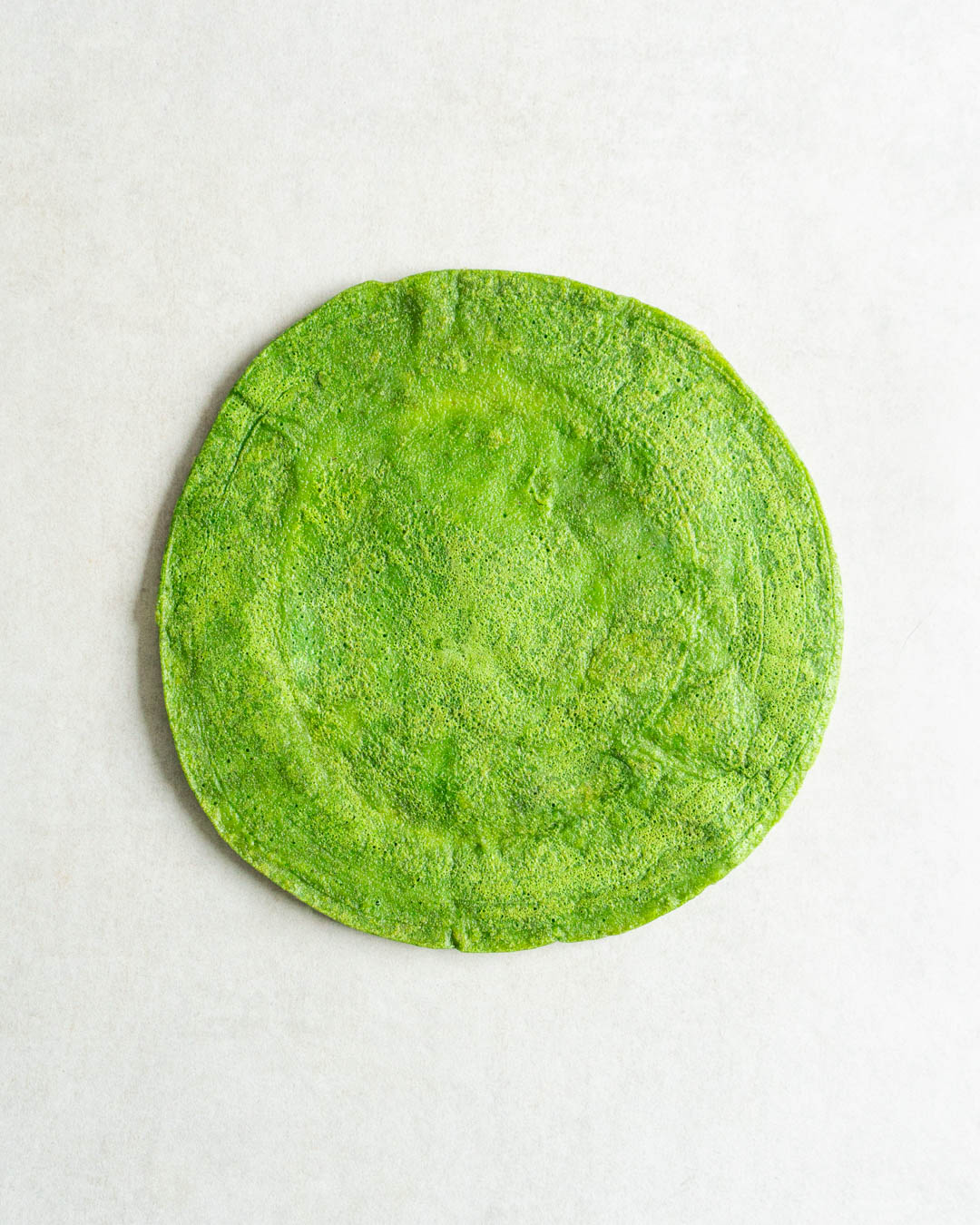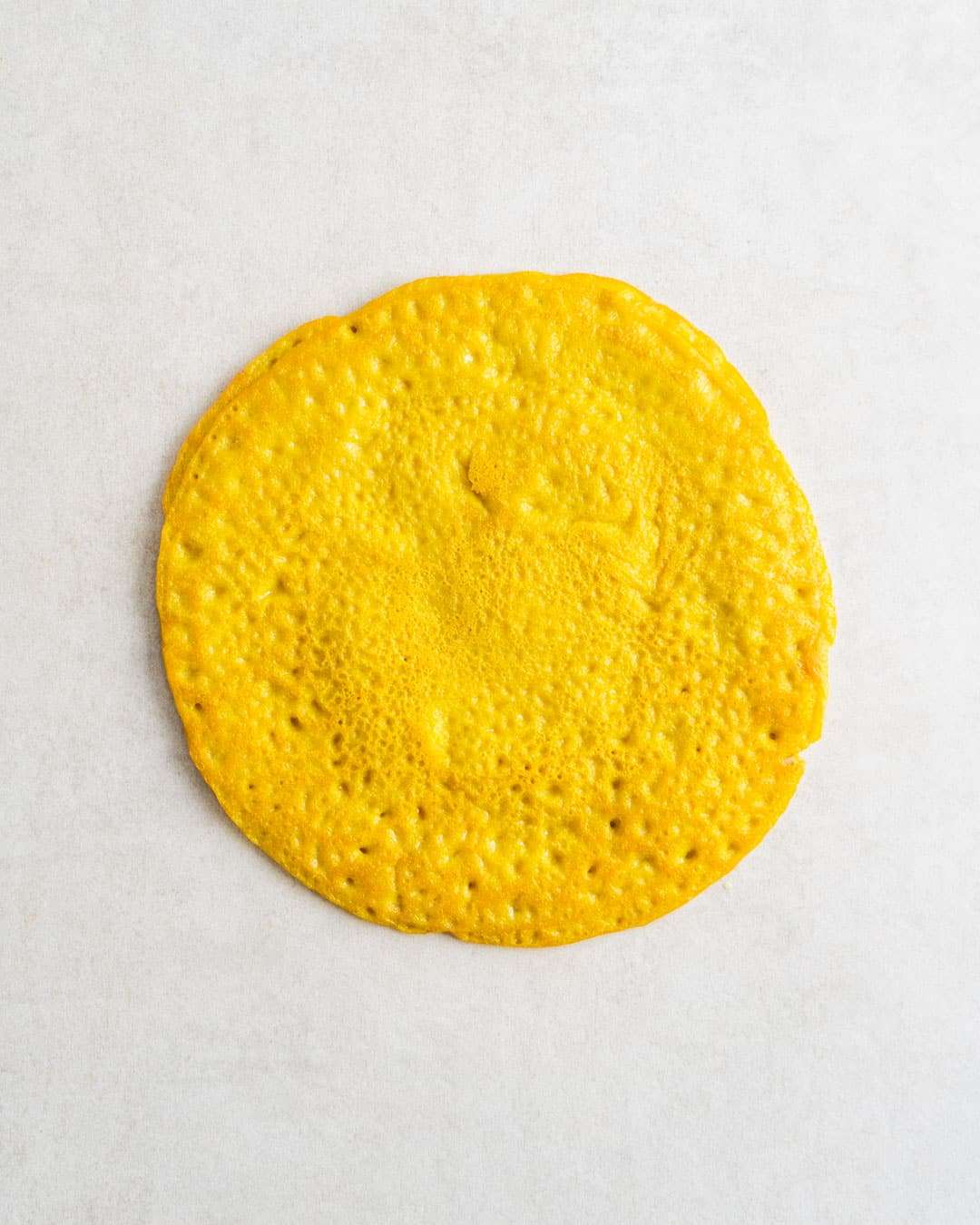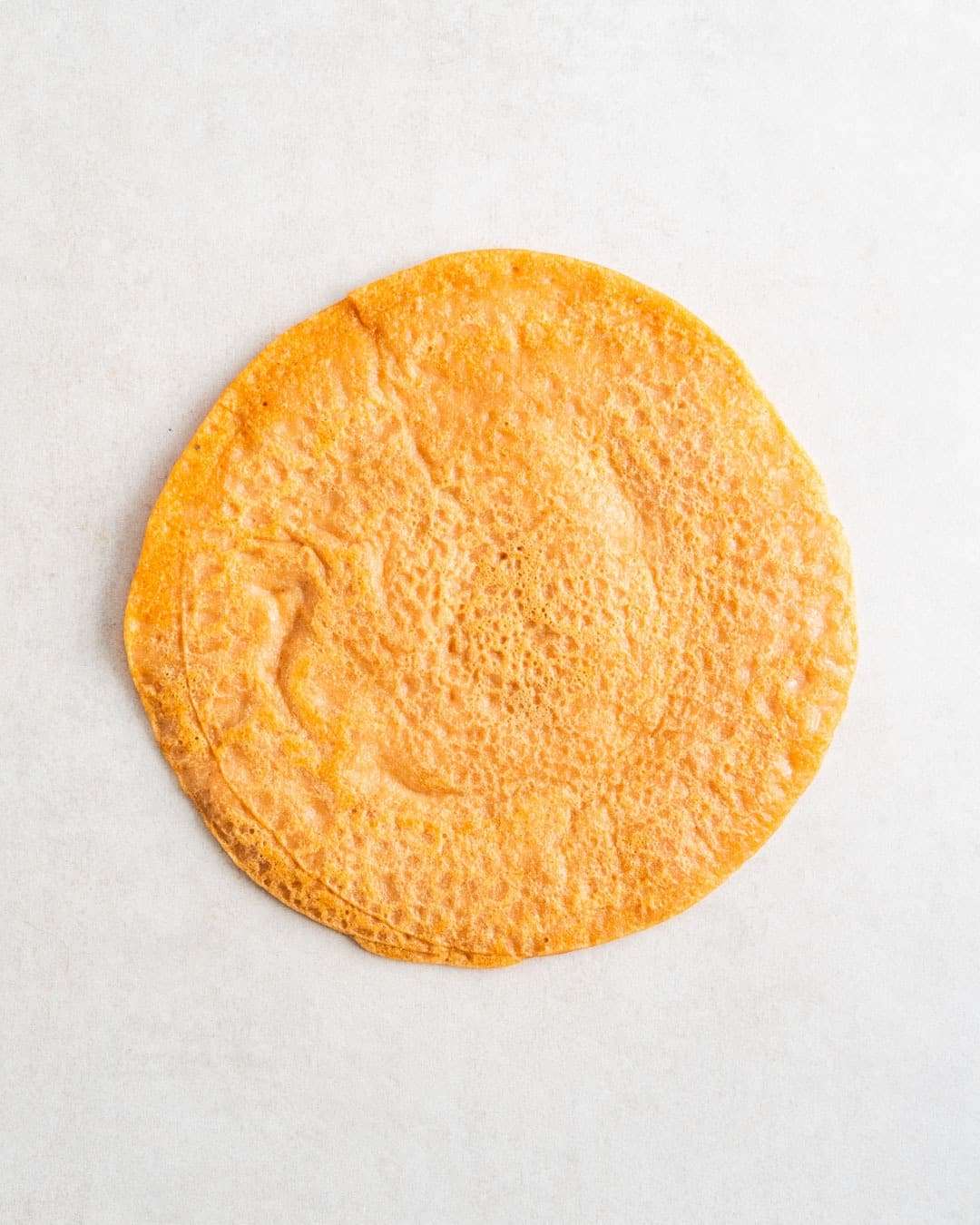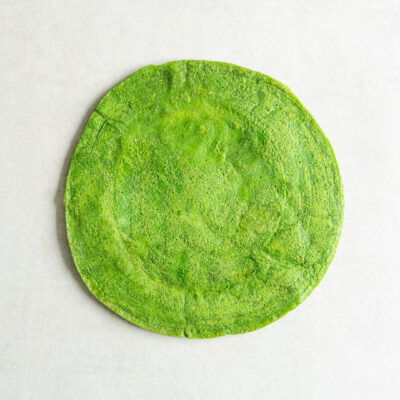Any Legume Pancakes

I’m determined that legumes need to play a more central role in our daily diet. They are a powerhouse, both nutritionally as well as in their contribution to nature (more on that below), and by simply choosing to eat them, we can support their diversity and those who grow them. These legume pancakes are an easy way to do exactly that. Because no matter which legumes you have access to, you can turn them into a savoury staple that can be flavoured in whichever way you like.
That legumes make the perfect base for pancakes may come as a surprise to some of us, but many Indians will already count this simple method to their everyday culinary arsenal. Besan Chilla, for instance, are thick North Indian breakfast “pancakes” that are made entirely from gram flour (ground, hulled black chickpeas). The starches in the chickpeas are sufficient to coagulate the batter, turning them into pancakes that are often topped with aromatics like tomatoes, onion and coriander. Delicious!
Another Indian breakfast staple, Dosa, is made from fermented lentils and rice. The right ratio of lentils to rice along with a proper fermentation will result in a risen batter than can be spread out thinly over a tawa and turned into a crispy pancake. A similar treat is Pesarattu, a dosa like pancake made from mung beans.
This Any-Legume-Pancake-Recipe is a hybrid of the easy-to-make Besan Chilla and the more complex Dosa. They are made with a combination of legumes and grains, turning them into a complete protein, but since they don’t require any fermentation, they are incredibly easy to whip up. All it takes is a little bit of foresight to remember soaking the legumes and grains the night before. The next day, it’s only a matter of blending it with water and the aromatics of your choice for a speedy pancake batter.
IMPORTANT: Most legumes contain natural toxins as a defence mechanism against wild predators. Whilst soaking and then cooking them will make them safe to consume, some legumes like red kidney beans contain additional toxins that are more difficult to break down and the cooking time for the pancakes might not be sufficient to do so. Although this recipes works in principle with any legume, I’d recommend sticking to the ones I’ve used below. If you’d like to experiment, it’s best to use lentils rather than beans, as they are generally easier to digest.

Chickpea Pancake
What is a Complete Protein?
A complete protein contains all nine essential amino acids that the human body cannot produce on its own and must obtain from the diet. Animal-based foods like meat, fish, eggs and dairy are typically complete proteins. However, many plant-based foods lack one or more essential amino acids, making them incomplete proteins.
Some plant foods, such as quinoa, soybeans (tofu, tempeh, edamame), chia seeds, hemp seeds and buckwheat, are complete proteins on their own. Others, like beans, lentils, nuts and seeds, are incomplete but can be combined with other sources to form complete proteins. For example, combining legumes with grains, grains with nuts or nuts with legumes can create a complete protein meal.
Our body can store these amino acids and combine them with those received from sources we consume at other times during the day. So eating a complete protein is not essential for every dish. However, combining different sources of proteins in a single meal makes it easier to cover the daily intake.

Red Lentil Pancake
Benefits of Legumes
Environmental Benefits
-
Nitrogen Fixation: Legumes have a unique ability to form symbiotic relationships with nitrogen-fixing bacteria in their root nodules. This process allows them to convert atmospheric nitrogen into a form that can be used by plants, which reduces the need for synthetic nitrogen fertilizers and contributes to soil fertility.
-
Soil Health: The growth of legumes enhances soil health by increasing organic matter content and improving soil structure. Their root systems help prevent erosion and promote water retention in the soil.
-
Crop Rotation: Legumes are often used in crop rotation systems due to their nitrogen-fixing properties. Planting legumes in rotation with other crops can reduce the need for chemical fertilizers, benefiting soil health and reducing environmental pollution.
-
Biodiversity: Incorporating legumes in agricultural systems can enhance biodiversity by providing habitat and food sources for beneficial insects and microorganisms. This can contribute to natural pest control and overall ecosystem balance.
-
Water Efficiency: Legumes typically require less water compared to many other crops, making them more resilient in areas prone to water scarcity or drought.
Health Benefits
-
Nutrient-Rich: Legumes are rich in essential nutrients such as protein, dietary fibre, complex carbohydrates, vitamins (folate, vitamin B6, thiamin), and minerals (iron, potassium, magnesium).
-
Protein Source: Legumes are an excellent plant-based source of protein, especially when on a plant-based diet.
-
Low in Fat: Legumes are generally low in saturated fat and cholesterol. Their consumption can contribute to heart health by helping to lower bad cholesterol levels.
-
Dietary Fibre: The high fibre content of legumes supports digestive health, helps regulate blood sugar levels, and promotes a feeling of fullness that lasts longer throughout the day.
-
Blood Sugar Regulation: The combination of complex carbohydrates and fibre in legumes leads to a slower release of sugars into the bloodstream, which can help stabilise blood sugar levels.
-
Gut Health: Legumes can act as prebiotics, providing nourishment for beneficial gut bacteria.
-
Antioxidants: Some legumes, such as lentils and black beans, contain antioxidants that help protect cells from oxidative stress and inflammation.
Storage
The pancakes are best made fresh, as they will toughen up quite quickly. But you can keep the batter in the fridge for 2-3 days.
3x batches of either pancake batter serves 4
Ingredients
Mung Bean Pancakes
- 100g dried mung beans
- 50g basmati rice (or other grains)
- 50g spinach
- 10g ginger
- 1 green chili
- 1/2 tsp cumin seeds
- 3/4 tsp salt
- 1 tbsp oil
Chickpea Pancakes
- 100g dried chickpeas
- 50g basmati rice (or other grains)
- 10g ginger
- 1 green chili
- 1/2 tsp cumin seeds
- 3/4 tsp salt
- 1/2 tsp turmeric
- 1 tbsp oil
Red Lentil Pancakes
- 100g dried red lentils
- 50g basmati rice (or other grains)
- 10g ginger
- 1/2 tsp cumin seeds
- 3/4 tsp salt
- 1/2 tsp Kashmiri chilli powder
- 1 tbsp oil
Method
For the Mung Bean Pancakes
Add the mung beans and rice to a bowl and wash them 3-4 times until the water runs almost clear, then soak them in at least 500ml of water overnight.
The next day, drain them and grind (I used my Vitamix E310) together with the spinach, ginger, chilli, cumin seeds, salt and enough water (150-200ml) to form a pourable batter.
Heat 1 tsp of the oil in a non-stick frying pan over medium heat. Add a ladle of the batter, spreading it out into a thin pancake with the back of the ladle.
Drizzle some more oil around the edges and fry the pancake until it easily loosens from the pan (1-2 mins). Flip it over and fry the other side until cooked through (1-2 mins). Set aside and continue with the remaining batter.
For the Chickpea Pancakes
Follow the steps above to make the batter with 200-250ml water (but don’t add the turmeric yet). Pour the batter into a bowl and mix in the turmeric, then fry as instructed above.
For the Red Lentil Pancakes
Follow the steps above to make the batter with 75-125ml water, including the chilli powder. Then fry as instructed above.
IMPORTANT: Most legumes contain natural toxins as a defence mechanism against wild predators. Whilst soaking and then cooking them will make them safe to consume, some legumes like red kidney beans contain additional toxins that are more difficult to break down and the cooking time for the pancakes might not be sufficient to do so. Although this recipes works in principle with any legume, I’d recommend sticking to the ones I’ve used below. If you’d like to experiment, it’s best to use lentils rather than beans, as they are generally easier to digest.
**I receive a small commission from affiliate links on this page**

Any Legume Pancakes
Ingredients
Mung Bean Pancakes
- 100 g dried mung beans
- 50 g basmati rice (or other grains)
- 50 g spinach
- 10 g ginger
- 1 green chili
- 1/2 tsp cumin seeds
- 3/4 tsp salt
- 1 tbsp oil
Chickpea Pancakes
- 100 g dried chickpeas
- 50 g basmati rice (or other grains)
- 10 g ginger
- 1 green chili
- 1/2 tsp cumin seeds
- 3/4 tsp salt
- 1/2 tsp turmeric
- 1 tbsp oil
Red Lentil Pancakes
- 100 g dried red lentils
- 50 g basmati rice (or other grains)
- 10 g ginger
- 1/2 tsp cumin seeds
- 3/4 tsp salt
- 1/2 tsp Kashmiri chilli powder
- 1 tbsp oil
Instructions
For the Mung Bean Pancakes
- Add the mung beans and rice to a bowl and wash them 3-4 times until the water runs almost clear, then soak them in at least 500ml of water overnight.
- The next day, drain them and grind (I used my Vitamix E310) together with the spinach, ginger, chilli, cumin seeds, salt and enough water (150-200ml) to form a pourable batter.
- Heat 1 tsp of the oil in a non-stick frying pan over medium heat. Add a ladle of the batter, spreading it out into a thin pancake with the back of the ladle.
- Drizzle some more oil around the edges and fry the pancake until it easily loosens from the pan (1-2 mins). Flip it over and fry the other side until cooked through (1-2 mins). Set aside and continue with the remaining batter.
For the Chickpea Pancakes
- Follow the steps above to make the batter with 200-250ml water (but don’t add the turmeric yet). Pour the batter into a bowl and mix in the turmeric, then fry as instructed above.
For the Red Lentil Pancakes
- Follow the steps above to make the batter with 75-125ml water, including the chilli powder. Then fry as instructed above.

Thank you so much for great recipes filled with nutrition and knowledge.
Your recipes are as simple yet effective as you are. May God bless you with His best. ????♥️
Hi, your recipes are amazing!
I’ll try all your legume pancakes ????
Amazing! Let me know if you liked them.
Great recipe, thank you for sharing! Do these pancakes freeze well?
I fear they’d be quite stale if reheated from frozen, although I’ve seen recommendations to freeze other legume pancakes. Haven’t tried it yet myself, I’m afraid. Definitely the best option for storage, rather than keeping it in the fridge.
That’s very kind of you, thanks!
These look amazing. Quick question, is it possible to batch cook the pancakes and then freeze them? I have been looking for decent gluten free pancakes for a looooong time????
Thank you!
I’ve heard it is, but I haven’t tried it yet. I’d assume they would be slightly stale when re-heated. Maybe try it with a smaller batch first.
Thabk you for sharing. I tried w the chickpea and it was good.
But the red lentil… the 1st time it smelled off – sour. I’m trying for the 2nd time, rinsed several times and change the soaking water every 2 hrs.
Will update.
Hmm, maybe the ambient temperature is too warm and they went off. You actually don’t need to soak red lentils. So maybe try this by soaking only the rice for the recommended time and add the lentils to the water to soak for just 1hr to aid digestion.
I love the looks of your recipes. I see above you mention that some plants are not complete proteins. I thought you might like this reference from nutrition facts.org https://nutritionfacts.org/blog/do-you-have-to-combine-plant-proteins-at-a-meal/
Hi Cate, thanks for sharing. It’s not so much that you need to combine them in one individual meal, but you should still consume a balance of different sources over the course of the day. So dishes that combine different protein sources are a win win. But good shout, I’ll try and update the wording!
Love your videos and selection of recipes!
Thank you so much!
Saw this on Insta and had to try! Got my chickpeas soaking now 🙂 I was wondering: why omit the turmeric when blending the chickpeas and add it later?
Only because it can easily stain your blender. Hope you liked it!
Ah makes sense! Thank you for sharing! I’ve been playing around with different legumes, spices and aromatics, fillings, so much fun and so delicious!!
Perfect! 🙂
These worked brilliantly! I’d love to see a recipe for the spiced mash potatoes you put with it on Instagram ????
Will try to add it soon! Glad you liked them 🙂
I made some by boiling cubed sweet potato, frying onions with garlic, basil, oregano, cajun spice, MTL steak spice, s+p, then adding in the softened potatoes and mashing it all together. served on a lentil pancake with sliced avocado, pumpkin seeds, and yogurt. I was just missing cilantro to take it to another level!
That sounds incredible! ????
Made the chickpea pancakes tonight – delicious and nutritious! Thank you! We are them with a potato masala! Looking forward to trying the others too. Love your recipes!
Perfect combo! I’m glad you liked them.
This may be the answer to my prayer! I cannot process gluten and many wheat products. I miss tortillas and this may be a great substitute. But, I am also diabetic and try to reduce my carb load. Do you think I could substitute the rice with walnuts? That would create a complete protein but I don’t have any experience with this recipe and am afraid that I won’t know if a fail is due to the substitution or from another cooking error. I would appreciate your advice.
You can actually substitute the rice with another or the same legume as well. I haven’t tried nuts, but since they contain natural fats, there’s a chance it might affect the coagulation. Always worth giving it a shot.
Can you do this with other beans such as kidney or black? How would you adjust water? What are you looking for to know you’ve done it correctly when venturing into different legumes?
Should you do the soak in the fridge?
It seems like it might be challenging to get them blended well without there still being bits of ungrounded bean if you don’t have a vitamin… What about grinding dry before soaking and making it into a powder?
Thanks for checking. Some legumes, like red kidney beans, are more difficult to digest for the body, because they contain natural toxins. To make them safe to eat, they need to be soaked and cooked long enough, so for this particular recipe, I’d recommend sticking to safer legumes like any form of dried peas, lentils and smaller beans like mung beans. I will update the recipe to reflect this as well!
If you’re in a very warm climate, you can also soak the legumes in the fridge.
I did not expect these to be that good. i suggest soaking for atleast 24 hours as the legumes and grains are still hard after 8 hours or overnight. Thank you! i am still trying to get better at spreading this. Looks like thinner batter helps a lot
I’m glad you liked them! Absolutely, you can soak them for up to 24 hours 🙂
Could I use canned legumes, rather than starting from dry and soaking myself?
Unfortunately not. Canned legumes are pre-boiled and will have lost some of their properties that you’d need for the pancakes to hold their shape.
Would a regular blender be sufficient? I don’t have a high-speed one. Thanks!
Yes, just avoid a food processor! A regular blender should still do the job as long as the batter does not end up ‘coarse’.
Hi! The recipe looks really good. I tried it with red lentils and thin bulgur to avoid soaking overnight & added sun dried tomatoes& more spices into the blender. the taste was good but the texture was very unpancake-able and it ended up becoming a sticky mush when cooked, so I had some sticky mush for breakfast. I think this might be because I replaced rice with bulgur. Will try with rice another day. Take care 🙂
Did you change the ratio? The lentils should still coagulate enough to hold it together. I’m sorry to hear that! Maybe try the recommended ratio and indeed with rice instead of bulgur. Your additions sound delicious, but maybe the sun-dried tomatoes also stopped it from coagulating.
I made the red lentil pancake and used it like a wrap this morning. I stuffed the wrap with some potato masala, it was delish. I beleive the addition of the rice to this recipe really changes the texture and binding of the wrap. I will try your besan wrap next time.
Sounds delicious! Yes, the rice definitely helps with the texture! Enjoy the besan!
i love it. cannot also use brown rice.
Absolutely, that’ll be great!
I keep making the mung bean version. It is fantastic! Texture wirs out perfectly every time. You truly have tested these recipes over and over again. Thank you!